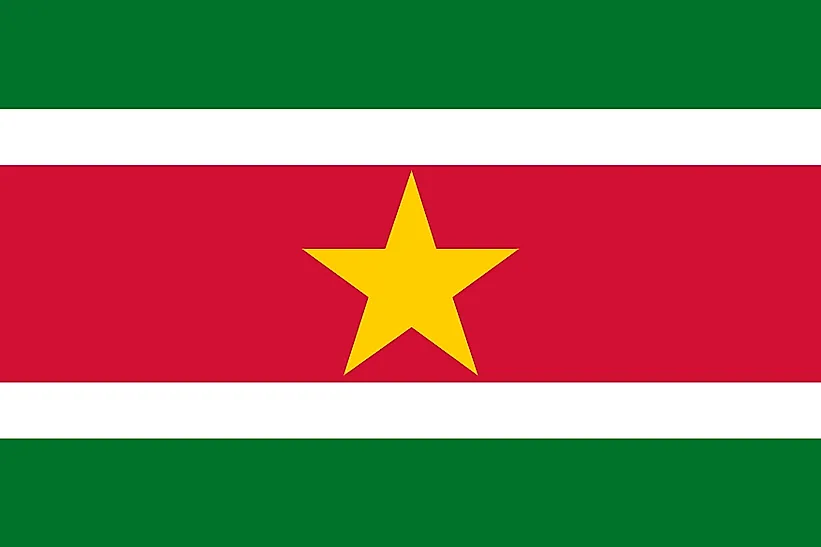
スリナム
| 大陸 | 米州 |
| 資本金 | パラマリボ |
| 人口 | 585,824 |
| GDP | $8.55 億ドル |
| 一人当たりGDP | $15,200 |
| ダイヤルコード | +597 |
| ISOコード(2文字) | SR |
| ISOコード(3文字) | サー |
スリナム 風景






スリナムについて
スリナムへようこそ!スリナムは、驚くべき多様性と豊かな自然に恵まれた国です。163,821平方キロメートルに約60万人の人口を擁するスリナムは、類まれな生物多様性とユニークな文化の融合を兼ね備え、南米で最も多様な民族が暮らす国のひとつとなっています。
地理的特徴と自然の美しさ
スリナムの地理は、海岸沿いの平原から手つかずの熱帯雨林まで、多様な景観を包含している。国土の約80%を占めるアマゾンの熱帯雨林、中央スリナム自然保護区、広大な河川水系が特徴である。
熱帯雨林、サバンナ、マングローブの湿地帯が広がる。変化に富んだ地形が多様な生態系を生み出し、ジャガー、オオカワウソ、数百種の鳥類など、ユニークな野生生物を支えている。
保護地域には、160万ヘクタールにおよぶユネスコ世界遺産の中央スリナム自然保護区がある。スリナムの自然保護への取り組みは、持続可能な開発を推進しながら、手つかずの熱帯雨林を保護することに重点が置かれている。
文化遺産と伝統
スリナムの文化は、先住民、アフリカ人、アジア人、ヨーロッパ人の影響が融合したユニークなものである。パラマリボの特徴的な建築物、多様な宗教的伝統、豊かな芸術表現など、スリナムの遺産は多岐にわたる。
伝統芸術には、木彫り、織物芸術、カセコやカウィナをはじめとするさまざまな音楽スタイルがある。文化的な慣習としては、多様な宗教儀式、ディヴァリやイードのような祭り、ユニークな料理の伝統などがある。
スリナム料理は多文化の伝統を反映しており、ロティ、ポン、ナシゴレンといった料理が特徴である。多文化を祝い、コミュニティが集う伝統は、今も国のアイデンティティの中心となっている。
歴史の旅
スリナムの歴史は、先住民の入植からオランダの植民地化、そして独立にまで及んでいる。独自の発展を遂げたスリナムは、南米で最も多様性に富んだ社会のひとつである。
重要な時代には、オランダの植民地化、プランテーション時代、労働者としてさまざまな民族がやってきた時代、そして1975年の独立がある。異なる文化が平和的に共存するこの国は、多様性のモデルとなっている。
現代の経済状況
今日のスリナム経済は、天然資源、農業、エコツーリズムに重点を置いている。スリナムには、金やボーキサイトをはじめとする重要な鉱業資源がある。
最近の取り組みでは、持続可能な資源管理、エコツーリズムの開発、農業の多様化を重視している。スリナムの自然の豊かさと文化の多様性は、その経済的潜在力を支えている。
国際関係とグローバルポジション
スリナムはカリブ海や南米の組織に積極的に参加しながら、グローバルなパートナーシップを育んでいる。スリナムの環境保護と文化的多様性は、外交的影響力を拡大している。
ご存知でしたか?
- スリナムは、モスクの隣にシナゴーグを見つけることができる数少ない国のひとつですか?
- 熱帯雨林の割合が世界で最も高い国のひとつは?
- オランダ語が公用語であることは、南米でもユニークなのだろうか?
- この国には珍しいアオドウガネが生息しているのか?
結論
スリナムは、文化の多様性と自然保護のユニークな組み合わせを象徴しています。手つかずの熱帯雨林から多文化が共存する首都、伝統的な慣習から近代的な開発まで、スリナムはその独特な個性を守りながら進化を続けている。持続可能な開発や経済の多様化などの課題に取り組む中で、スリナムは文化的調和と環境保護のモデルとしての地位を維持しながら、前進を続けています。